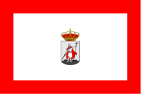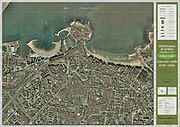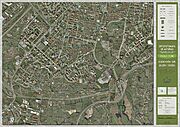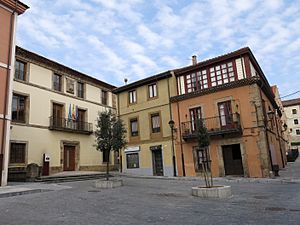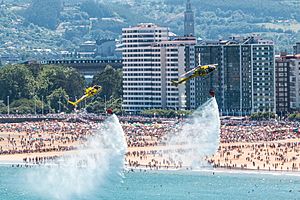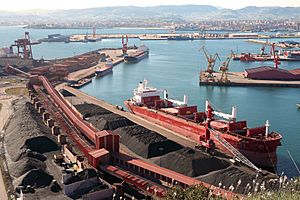Gijón facts for kids
Quick facts for kids
Gijón
Xixón (Asturian)
|
|||
|---|---|---|---|
| Gijón / Xixón | |||
|
Aerial view
Jovellanos Theater
Elogio del Horizonte
City hall
Panoramic view
|
|||
|
|||
| Country | Spain | ||
| Autonomous community | Asturias | ||
| Founded | 5th century BC (Noega, the first settlement on record) | ||
| Area | |||
| • Total | 181.6 km2 (70.1 sq mi) | ||
| Elevation | 3 m (10 ft) | ||
| Highest elevation | 737 m (2,418 ft) | ||
| Lowest elevation | 0 m (0 ft) | ||
| Population
(2019)
|
|||
| • Total | 271,780 | ||
| • Density | 1,496.6/km2 (3,877.0/sq mi) | ||
| Demonyms | gijonés, -esa (es) xixonés, -esa (ast) |
||
| Time zone | UTC+1 (CET) | ||
| • Summer (DST) | UTC+2 (CEST) | ||
| Postal code |
33201–33212
|
||
| Official language(s) | Spanish | ||
Gijón (pronounced hee-HOHN) or Xixón (in Asturian) is a large city and area in north-western Spain. It is the biggest city in the region of Asturias by population. Gijón is located on the coast of the Cantabrian Sea, part of the Bay of Biscay. It's about 24 kilometers (15 miles) northeast of Oviedo, the capital of Asturias. As of 2023, Gijón is the 15th largest city in Spain, with over 273,000 people.
Gijón is part of a big metropolitan area. This area includes many towns and has a population of over 835,000 people. It has a good network of roads, highways, and railways.
In the past, Gijón was known for its steel and shipbuilding industries. However, these industries have changed. Now, Gijón is becoming a popular place for tourists, students, and businesses. It is also a center for research and development. The city is home to the Radiotelevisión del Principado de Asturias (a TV and radio station), the historic Cimavilla neighborhood, and the impressive Universidad Laboral de Gijón.
Contents
- What's in a Name? The History of Gijón's Name
- A Journey Through Time: Gijón's History
- Where is Gijón? Exploring its Geography
- How Gijón is Organized: Districts and Neighborhoods
- Who Lives in Gijón? Population Facts
- Arts and Fun: Gijón's Culture
- Getting Active: Sports in Gijón
- How Gijón Makes Money: The Economy
- Getting Around: Transport in Gijón
- Famous Faces from Gijón: Notable People
- Gijón's Global Connections: Twin Cities
- Images for kids
- See also
What's in a Name? The History of Gijón's Name
The name "Gijón" has an interesting past. One idea is that it comes from an old word, "Gigia." This word might be linked to the Greek word "gigias," meaning "giant." This could refer to a large Roman wall built in the Cimavilla area. The Romans called this wall "Gegionem," which also means something "gigantic." Perhaps it referred to the large size of the wall or the people who lived there.
Another idea, which is more accepted today, is that the name comes from a Roman name "Sessio." Over many centuries, this might have changed into "Xixón" in the Asturian language. The Spanish name "Gijón" then came from this Asturian word.
A Journey Through Time: Gijón's History
Gijón has a long and rich history, stretching back thousands of years.
Ancient Times: Prehistory and Roman Influence
The first signs of people living in the Gijón area are very old. You can find ancient burial mounds (called tumuli) on Monte Deva. On Monte Areo, there are dolmens, which are stone structures built around 5000 BC.
The first known settlement was called Noega. It started between 600 and 500 BC. People called Astures lived there. Later, the Romans arrived and built a wall on the Cimavilla peninsula. This wall was known as the Gegionem.
Middle Ages to Modern Growth
After the Romans, the region was ruled by the Visigoths in the 7th century. This was when Christianity began to spread. Gijón was briefly the capital of Muslim lands in the Cantabrian Sea between 713 and 722. In 722, the Asturians, led by Pelagius, won the Battle of Covadonga. This battle is seen as the start of the Reconquista, a long period when Christian kingdoms took back control of Spain.
Gijón became an official town in 1270, thanks to King Alfonso X of Castile. In the 14th century, a war caused Gijón to be almost completely destroyed. But the town grew back in the 15th and 16th centuries. A new dock was built, helping fishing and trade.
In the 17th and 18th centuries, Gijón developed quickly. It grew beyond its old city center, trading with American colonies. After some difficult times, a road connecting Oviedo and Gijón was built. The port became very important, leading to the start of industrial activities.
Gijón in Recent History
The 19th century brought great growth to Gijón. Coal trade, new roads, and railways helped the port expand rapidly. A new, bigger port called El Musel was built in 1893. It became Spain's first major coal port.
Gijón became an industrial city with new streets, squares, and public services like water and lighting. Many new workers came, and new neighborhoods were built.
During the Spanish Civil War in the 20th century, Gijón supported the Republican side. The city was the capital of the Sovereign Council of Asturias and León until 1937, when General Francisco Franco's troops took control.
Iron manufacturing was Gijón's main industry from the late 1800s until the late 1900s. However, the iron and shipbuilding industries faced a crisis. This led to changes in the city, with new beaches, parks, and neighborhoods being created. A campus of the University of Oviedo was also built here.
Where is Gijón? Exploring its Geography
Gijón's Location and Surroundings
Gijón is located on the coast of central Asturias. Its elevation ranges from sea level up to 513 meters (1,683 feet) at Picu Samartín. To the west, it borders Carreño, to the east, Villaviciosa, and to the south, Siero and Llanera.
The city is known for the Cimavilla peninsula. This peninsula divides the San Lorenzo beach and its nearby areas to the east from the Poniente and Arbeyal beaches, shipyards, and the port of El Musel to the west. Gijón is also close to other major Asturian cities like Oviedo and Avilés.
Understanding Gijón's Climate
Gijón has a mild oceanic climate. This means it has cool summers and wet, mostly mild winters. The winds from the Atlantic Ocean keep the temperatures from getting too hot or too cold. Extreme heat or very cold weather is rare. The climate is wetter and cloudier compared to other parts of Spain, but it's actually drier than some other places on the Atlantic coast. It's also quite humid all year round.
How Gijón is Organized: Districts and Neighborhoods
Gijón is divided into six main districts: Center, East, South, West, El Llano, and Rural. The Rural district includes all the areas outside the main city, like the rural parishes.
Neighborhoods and Parishes of Gijón
|
|
Who Lives in Gijón? Population Facts

In 2021, Gijón had 268,896 people living there. The city's population grew a lot during the 20th century, especially from the 1960s to the 1980s. During this time, the population doubled. After the 1990s, growth slowed down. However, with people moving in from other parts of Asturias and from other countries, the population started to increase again in the early 2000s.
Arts and Fun: Gijón's Culture
Gijón offers many cultural activities all year. These activities become even more frequent in the summer, especially in August during the Feast of the Assumption. You can enjoy parties, music, and theater shows. The Jovellanos Municipal Theater also has a continuous program of events.
Some of the main festivals and events in Gijón include:
- The Iberoamerican Book Fair in May.
- The Semana Negra (Black Week) in July.
- The Feria Internacional de Muestras de Asturias (Asturias International Trade Fair).
- The Gijón International Film Festival.
- The Semana Mágica Festival (Magic Week Festival) in December.
The Universidad Laboral de Gijón, finished in 1955, is a huge building. It now houses the LABoral Centro de Arte y Creación Industrial. This center opened in 2007. It's a place for art, science, technology, and creative industries to come together.
Gijón has also been a stop for the famous Cirque du Soleil. Their shows have been very popular in the city.
Gijón is the birthplace of many famous people. One important person was Gaspar Melchor de Jovellanos. He was a statesman, writer, and philosopher during the Age of Enlightenment.
Gijón in Movies
Many movies have been filmed in Gijón. For example, parts of the film Volver a empezar were shot here. This movie later won an Academy Award for Best Foreign Film. The comedy Mortadelo & Filemon: The Big Adventure also filmed some scenes in the City of Culture of Gijón. In 2009, the Laboral building was even transformed to look like the University of Oxford for the movie Brain Drain.
Museums and Art Galleries to Explore
Gijón has many interesting museums and art galleries:
- Museum of the Asturian People
- Railway Museum of Asturias
- Nicanor Piñole museum
- Roman Terms museum of Campo Valdés
- Juan Barjola Museum (features a local painter and avant-garde art)
- Evaristo Valle museum (a local painter's museum in a mansion)
- International Bagpipe Museum (shows bagpipes from around the world, especially Asturian ones)
- Atlantic botanical garden
- Archaeological park Campa Torres
- Revillagigedo Palace and museum (near the City Hall)
- Gijón Aquarium
- Roman Town of Veranes
- LABoral Centro de Arte y Creación Industrial (for contemporary art, science, and technology)
Learning in Gijón: Universities
Gijón has two university campuses. One is part of the University of Oviedo, and the other is for the National University of Distance Education.
University of Oviedo Campus
The Gijón Polytechnic School of Engineering offers degrees in various engineering fields. These include Mechanical, Electrical, Electronic, Computer, Chemical, and Telecommunication Engineering. There is also a School of Civil Navy and a Faculty of Commerce, Tourism, and Social Sciences.
National University of Distance Education (UNED)
Gijón also has a branch of the UNED. This university allows students to study different subjects from a distance.
Getting Active: Sports in Gijón
Gijón is home to the professional football team, Sporting de Gijón. They play in Spain's second division. The CP Gijón Solimar is a very important women's roller hockey team in Europe. They have won the European Cup five times!
Círculo Gijón is the city's main basketball team. Gijón also has a large private sports club called Real Grupo de Cultura Covadonga, with over 33,000 members. It's the biggest club in Asturias.
The CSI Gijón is Spain's official show jumping horse show. It takes place every year at Las Mestas Sports Complex.
Near Gijón, you can find several ski resorts in Asturias, like Valgrande-Pajares. The city's marina is a base for many water sports. The Royal Astur Yacht Club is the most important yacht club in town. In 2022, Gijón hosted an ATP tennis tournament for the first time.
Top Sports Venues in Gijón
The biggest sports venues in Gijón are:
- Estadio El Molinón, a football stadium with 30,000 seats.
- Plaza de Toros de El Bibio, an arena with 12,000 seats.
- Palacio de Deportes, a sports hall with 5,000 seats.
Games were played in Gijón during the 1982 FIFA World Cup.
The city also has 13 public sports centers. These centers have swimming pools, gyms, and saunas. Swimming pools are free for children up to 14 years old.
How Gijón Makes Money: The Economy
For much of the 20th century, Gijón's economy relied heavily on big industries like steel. However, in recent decades, jobs in the service sector (like tourism and business) have grown quickly.
The port is very important to many local businesses. Besides port-related activities, Gijón's economy is based on tourism, steel production (Arcelor), other metal industries, farming, and fishing.
Getting Around: Transport in Gijón
Air Travel to Gijón
Gijón is served by Asturias Airport. It's about 38 kilometers (24 miles) from the city center. You can reach the airport by motorway, national highway, or scheduled bus service.
Gijón's Seaport
The port of El Musel is very important for freight services. While ferry services to other countries have changed, El Musel remains a key port for goods.
Public Bus Services
Gijón has 18 bus lines that run daily. It also has four "Búho" (owl) lines. These owl services run on Friday and Saturday nights, and every night in July and August.
Train Travel
The city is served by the Gijón Railway Station.
Roads and Highways Connecting Gijón
Gijón is well-connected by a network of roads and highways. These include major highways like the A-8 (Autovía del Cantábrico) and the A-66 (Autovía Ruta de la Plata), which link Gijón to other important cities in Spain. There are also regional and local roads that connect Gijón to nearby towns and areas.
Famous Faces from Gijón: Notable People
Many well-known people were born in Gijón, including:
- Lara Álvarez (born 1986), a journalist and TV presenter.
- Pablo Carreño Busta (born 1991), a tennis player.
- Luis Enrique (born 1970), a famous football manager and former player.
- Gaspar Melchor de Jovellanos (1744–1811), a statesman, writer, and philosopher.
- Blanca Romero (born 1976), an actress, model, and singer.
Gijón's Global Connections: Twin Cities
Gijón has "twin city" or "sister city" relationships with several cities around the world. This means they share cultural and economic ties.
 Albuquerque, United States
Albuquerque, United States Havana, Cuba
Havana, Cuba Niort, France (since 1982)
Niort, France (since 1982) Novorossiysk, Russia (since 1986)
Novorossiysk, Russia (since 1986) Puerto Vallarta, Mexico
Puerto Vallarta, Mexico Smara, Western Sahara
Smara, Western Sahara
Images for kids
See also
 In Spanish: Gijón para niños
In Spanish: Gijón para niños







